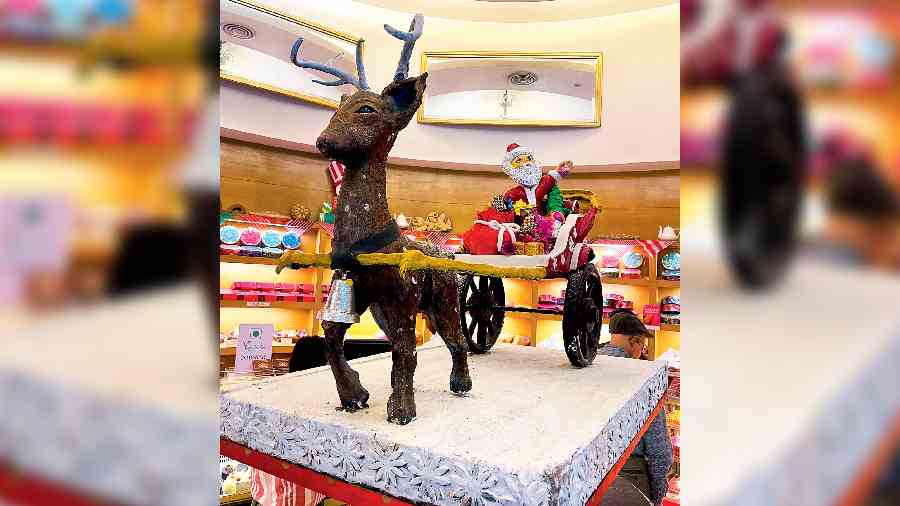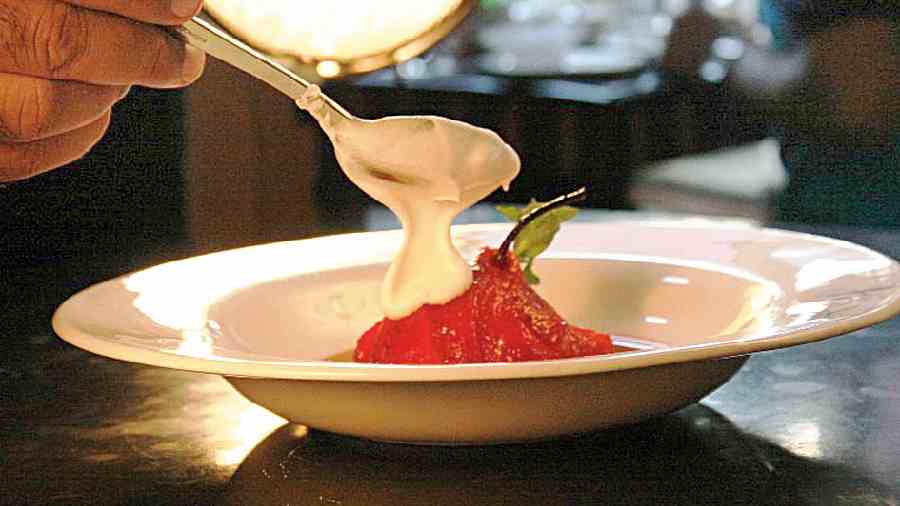Every year, for the last five years or so, I write a Christmas column for this publication; it is invariably the best-read column of the year and I receive the most feedback for it, although my topics are vastly different each year. A part of the reason is perhaps that I work for an organisation that defines the Christmas food celebrations in the city and we are widely known for our Christmas cakes that we sell in hundreds of thousands, as well as the Christmas dinner menus that are true to the celebratory traditions, going back to almost 100 years, since our inception.
An old friend, settled in Canada for decades came to visit me the other day and asked me a very innocuous question: Why do people in Kolkata celebrate Christmas in such a huge way, given that the population of Christians in the state is less than one per cent?! So, in a way, 99 people out of 100 that throng the various Christmas events, choc-a- bloc full street parties and stand in impossibly long queues to buy their pound of cake, are not celebrating what Christmas stands for as a religious festival. In fact, some might not even know what it is about, at all!
While it is true that Kolkata has a strong colonial heritage and many traditions of the erstwhile rulers found a place in the very secular Kolkatan’s mind and, also, that the mild, pleasant winters are quite inviting in themselves for people to come out of their homes and enjoy the outdoors, there is something else, and that something is that we have made this festival our ‘own’.
We have, for good reason, stopped to think of it as a festival for a few that profess the faith, but for all that want to have an occasion, a reason, an excuse to partake in the bonhomie of the season and enjoy the festivities in our own way. We do not really need to follow each tradition that comes with it, but just to choose the ones that require us to be cognisant and respectful of the religious aspect of it, but observe it in our own way.
For, at the end of it, all religions teach the same things — peace, empathy and love for all — and it’s only natural that we celebrate each other’s festivals, if for nothing else, then definitely for the delicious food that each festive occasion brings. And this is not as evident in any part of the world as it is in our city of joy — Kolkata.

The Boro Taana Rickshaw chocolate sculpture at Flurys is quite a rage now
For each festival, we at Flurys make a beautiful, detailed chocolate sculpture and display it at our flagship store. It catches a lot of attention and appreciation from all. our Chocolate Durga last year was shared in more than 200 web portals and became viral piece of news. This year, for Christmas we made something called ‘Boro Taana Rickshaw’, which is an amalgamation of the word ‘Boro Din’ (‘Christmas’ in Bangla) and ‘tana rickshaw’ (the unique hand-pulled rickshaw of Kolkata) and shows Rudolph, Santa’s reindeer, pulling the iconic Kolkata hand-pulled rickshaw with Santa riding with his goodie bags. The entire sculpture is made of chocolate and has been quite a rage since we displayed it. In doing so, we have tried to highlight the beauty of the Kolkata Christmas and used symbolisms to denote how it has become our own.
In many parts of the country and the world, the local customs and traditions have been homogeneously blended into this specific Christian festival and have become a part of their legacy, notwithstanding the fact that many of the traditions around Christmas, especially the ones followed by Christians, are quite specific and haven’t changed in the last many centuries. Let us discuss some unusual traditions that are associated with Christmas and how these have enriched this festival and its observance. Let us start with India itself.
No Pine, No Problem
One of the most enduring and recognisable Christmas traditions is to erect and decorate the lush, trinket-laden, conical Christmas tree. While traditionally, the Christmas tree is a pine tree, in many parts of the world, especially tropical countries, it is impossible to find a pine or a fir tree. But since tradition must be followed, a little improvisation is certainly in order.
In many parts of India, especially the southern states, it is quite popular to decorate a banana tree as a Christmas tree. We all know of the magic tree of banana, each part of which is used in one way or the other, especially in Bengal and now we know of one more. Some households also decorate mango trees and even decorate their homes with mango leaves. It is also customary in many tribal houses to light earthen ‘diyas’ for Christmas to signify the belief of Jesus Christ being the light of the world.
Then there is the delicious sweet snack, curiously called kalkala, something that is unheard of in any other part of the world, but this deep-fried snack made with semolina, sugar and flour is a harbinger of Christmas festivities in many parts of the country, especially in Goa and the southern states. At Flurys, we come out with the ‘cake of the season’ each year for Christmas, in addition to all the traditional festive cakes that we do, and for this year we have done one with the local flavours of nolen gur or date palm jaggery, the winter elixir of Bengal and locally sourced shredded coconut, subtly flavoured with cardamom and coconut milk. This cake is already among our top sellers for the season, our culinary tribute to this all-encompassing festival. In any case, the food itself is a religion for many and it’s no wonder that if one were to localise a religious celebration, food is where they’d probably begin with.
So, what date is December 25?
It might sound inconsistent with the observed belief to some, but more than 12 per cent of Christians globally do not celebrate Christmas on December 25, but rather on January 7! In fact, in many countries of Eastern Europe where the majority of the Christian population is Orthodox, December 25 is just another bitterly cold December day and is not even a declared public holiday. In countries like Egypt, where there is a mixed population of Christians belonging to different denominations, both December 25 and January 7 are celebrated as Christmas days with holidays on both days.
Thing is, the Orthodox Christians follow the Julian calendar, which was the solar calendar adopted by Roman ruler Julius Caesar in 46BC. As time passed, many astronomers of the time began questioning the veracity of the calendar and it was thought that the Julian system has certain inconsistencies. To modify it, the Gregorian calendar was introduced in 1582, but to correct the errors of the previous system, many days had to be skipped. So the Julian calendar is 13 days behind the Gregorian and, therefore, many Christian festivals including Christmas and Easter are celebrated 13 days later by a sizeable section of Christians that still follow the Julian calendar. Fun fact: Due to this change, the North American calendar of September 1752 has only 19 days as the day count went straight from 2 to 14, so basically, you went to bed on September 2 and woke up on September 14, how cool is that!
Got the goat
While there are many symbolisms attached to Christmas, the Swedish tradition of the Yule Goat has few equals. It is said that the tradition goes back to the 11th century when there was a man-sized goat led by Saint Nicholas that had the power to control the devil. By the 19th century, men in the family would dress up not as Santa Claus but in goat costumes to give gifts to children. The goat is also seen across Sweden on their Christmas trees usually made of straw.
In the town of Gavle in Sweden, there is a tradition of making a giant goat of straw, sometimes as high as 40 feet, during the festive season in continuance of this tradition. This straw goat is symbolic of the varied Christmas traditions across the world, but, somehow, despite the best efforts of the authorities, the straw goat is always destroyed before the New Year and that’s the strangest part of it.
Poached Pear in Red Wine with Eggnog Sabayon

There’s no Christmas without the comfort of home, the company of friends and family and some great food. While Christmas food has evolved over the years, it is still thankfully quite traditional and true to the grandiosity of the occasion. Most people prioritise cooking during Christmas and spend a fair part of the day preparing, serving and eating food that is not normally prepared at other times of the year, unless you’re in Japan, where the most famous Christmas food is KFC! In any case, I present the recipe for a delicious, seasonal and elegant dessert that has the characteristics of a very potent Christmas dinner finisher. It has fruit in it, has spices and alcohol, is deep red in colour and is served with eggnog, basically everything Christmas is about. Say hello to my Poached Pear in Red Wine.
Ingredients
- Fresh pears: 4
- Good quality semi-sweet red wine (such as a Merlot or a Cabernet): 300ml
- Water: 100ml
- Sugar: 100g
- Cinnamon stick: 1inch
- Star anise:1
- Fresh thyme: 10g
- Egg yolk: 4
- Fruity white wine (such as a Riesling): 100ml
- Ginger powder: A pinch
- Cinnamon powder: A pinch
- Nutmeg powder: A pinch
- Cardamom powder: A pinch
- Mace powder: A pinch
Method
- Pour the red wine, water, half the sugar, cinnamon stick, star anise and fresh thyme in a saucepan. Peel the pears and put the whole (along with the stem) in the liquid.
- Simmer gently till the pears are tender and the liquid has reduced by half. This will take 30-40 minutes. Cool.
- For the sabayon, whisk the egg yolk and the rest of the sugar until pale, add the wine while whisking continuously and, finally, add the spices.
- To serve place the room-temperature poached pear on the serving plate with a little of the reduced poaching liquor.
- Spoon over the sabayon, and serve immediately. A dollop of cream can be served alongside if desired.
Vikas Kumar is the executive chef of Flurys.You can reach him at vkumar@flurys.com






